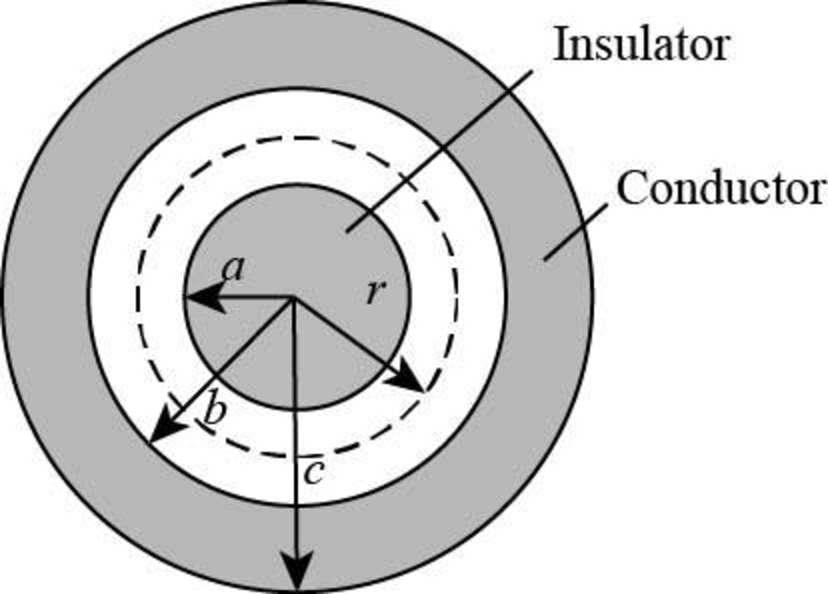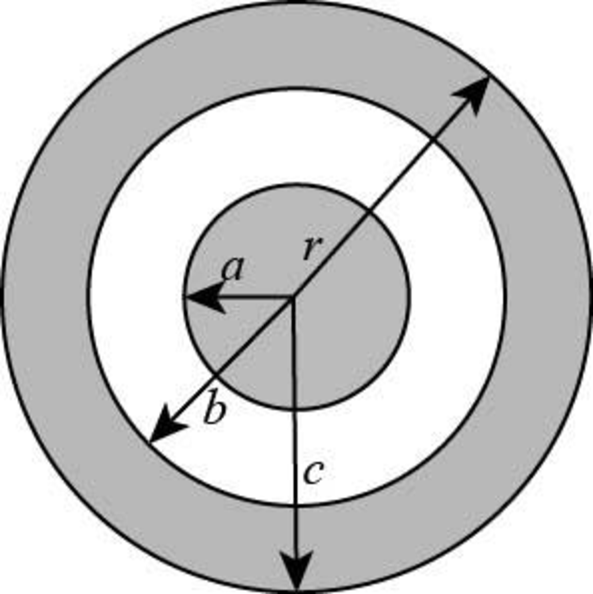
Concept explainers
(a)
The charge on the insulating sphere.
(a)
Answer to Problem 57AP
The charge on the insulating sphere is
Explanation of Solution
Draw a Gaussian sphere from the centre of the insulating sphere such that the radius of the Gaussian sphere is between

Figure-(1)
Here,
Write the expression to calculate the electric field at the radial distance
Here,
Conclusion:
Convert the units of
Substitute
The electric field at
Therefore, the charge on the insulating sphere is
(b)
The net charge on the hollow
(b)
Answer to Problem 57AP
The net charge on the hollow conducting sphere is
Explanation of Solution
Draw a Gaussian sphere from the centre of the insulating sphere such that the radius of the Gaussian sphere is greater than

Figure-(2)
Here,
Write the expression to calculate the electric field at the radial distance
Here,
Write the expression to calculate the total charge.
Here,
Conclusion:
Convert the units of
Substitute
The electric field at
Substitute
Therefore, the net charge on the hollow conducting sphere is
(c)
The charge on the inner surface of the hollow conducting sphere.
(c)
Answer to Problem 57AP
The charge on the inner surface of the hollow conducting sphere is
Explanation of Solution
The insulating sphere induces a charge on the inner surface of the hollow conducting sphere that has the same magnitude but has an opposite sign.
Therefore, the charge on the inner surface of the hollow conducting sphere is
(d)
The charge on the outer surface of the hollow conducting sphere.
(d)
Answer to Problem 57AP
The charge on the outer surface of the hollow conducting sphere is
Explanation of Solution
The charge on the outer surface of the hollow conducting sphere is equal to the net charge on the hollow conducting sphere minus the charge on the inner surface of the hollow conducting sphere.
Write the expression to calculate the charge on the outer surface of the hollow conducting sphere.
Here,
Conclusion:
Substitute
Therefore, the charge on the outer surface of the hollow conducting sphere is
Want to see more full solutions like this?
Chapter 24 Solutions
Physics for Scientists and Engineers with Modern, Revised Hybrid (with Enhanced WebAssign Printed Access Card for Physics, Multi-Term Courses)
- Two conductors having net charges of +14.0 µC and -14.0 µC have a potential difference of 14.0 V between them. (a) Determine the capacitance of the system. F (b) What is the potential difference between the two conductors if the charges on each are increased to +196.0 µC and -196.0 µC? Varrow_forwardPlease see the attached image and answer the set of questions with proof.arrow_forwardHow, Please type the whole transcript correctly using comma and periods as needed. I have uploaded the picture of a video on YouTube. Thanks,arrow_forward
- A spectra is a graph that has amplitude on the Y-axis and frequency on the X-axis. A harmonic spectra simply draws a vertical line at each frequency that a harmonic would be produced. The height of the line indicates the amplitude at which that harmonic would be produced. If the Fo of a sound is 125 Hz, please sketch a spectra (amplitude on the Y axis, frequency on the X axis) of the harmonic series up to the 4th harmonic. Include actual values on Y and X axis.arrow_forwardSketch a sign wave depicting 3 seconds of wave activity for a 5 Hz tone.arrow_forwardSketch a sine wave depicting 3 seconds of wave activity for a 5 Hz tone.arrow_forward
- The drawing shows two long, straight wires that are suspended from the ceiling. The mass per unit length of each wire is 0.050 kg/m. Each of the four strings suspending the wires has a length of 1.2 m. When the wires carry identical currents in opposite directions, the angle between the strings holding the two wires is 20°. (a) Draw the free-body diagram showing the forces that act on the right wire with respect to the x axis. Account for each of the strings separately. (b) What is the current in each wire? 1.2 m 20° I -20° 1.2 marrow_forwardplease solve thisarrow_forwardplease solve everything in detailarrow_forward
- 6). What is the magnitude of the potential difference across the 20-02 resistor? 10 Ω 11 V - -Imm 20 Ω 10 Ω 5.00 10 Ω a. 3.2 V b. 7.8 V C. 11 V d. 5.0 V e. 8.6 Varrow_forward2). How much energy is stored in the 50-μF capacitor when Va - V₁ = 22V? 25 µF b 25 µF 50 µFarrow_forward9). A series RC circuit has a time constant of 1.0 s. The battery has a voltage of 50 V and the maximum current just after closing the switch is 500 mA. The capacitor is initially uncharged. What is the charge on the capacitor 2.0 s after the switch is closed? R 50 V a. 0.43 C b. 0 66 C c. 0.86 C d. 0.99 C Carrow_forward
 Physics for Scientists and Engineers: Foundations...PhysicsISBN:9781133939146Author:Katz, Debora M.Publisher:Cengage Learning
Physics for Scientists and Engineers: Foundations...PhysicsISBN:9781133939146Author:Katz, Debora M.Publisher:Cengage Learning
 Principles of Physics: A Calculus-Based TextPhysicsISBN:9781133104261Author:Raymond A. Serway, John W. JewettPublisher:Cengage Learning
Principles of Physics: A Calculus-Based TextPhysicsISBN:9781133104261Author:Raymond A. Serway, John W. JewettPublisher:Cengage Learning Physics for Scientists and Engineers with Modern ...PhysicsISBN:9781337553292Author:Raymond A. Serway, John W. JewettPublisher:Cengage Learning
Physics for Scientists and Engineers with Modern ...PhysicsISBN:9781337553292Author:Raymond A. Serway, John W. JewettPublisher:Cengage Learning Physics for Scientists and EngineersPhysicsISBN:9781337553278Author:Raymond A. Serway, John W. JewettPublisher:Cengage Learning
Physics for Scientists and EngineersPhysicsISBN:9781337553278Author:Raymond A. Serway, John W. JewettPublisher:Cengage Learning Physics for Scientists and Engineers, Technology ...PhysicsISBN:9781305116399Author:Raymond A. Serway, John W. JewettPublisher:Cengage Learning
Physics for Scientists and Engineers, Technology ...PhysicsISBN:9781305116399Author:Raymond A. Serway, John W. JewettPublisher:Cengage Learning





